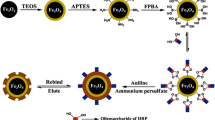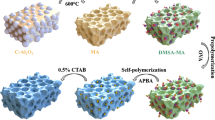Abstract
Boronate-affinity based molecularly imprinted polymers (MIPs) are beset by the unsatisfied adsorption capacity and narrow working pH ranges. A magnetic molecularly imprinted polymer containing phenylboronic acid groups was placed on the surface of Fe3O4 (magnetite) microspheres coated with porous TiO2 (Fe3O4@pTiO2@MIP). In contrast to its silica analog (Fe3O4@SiO2@MIP), the flowerlike Fe3O4@pTiO2 offers more binding sites for templates. Thus, the adsorption capacity of the Fe3O4@pTiO2@MIP is strongly enhanced. The strong electron-withdrawing effects of Ti(IV) enable the boronic acid of the MIP to have better affinity for glycoproteins at a wide pH range from 6.0 to 9.0. Consequently, the Fe3O4@pTiO2@MIP exhibits higher adsorption for glycoproteins than Fe3O4@SiO2@MIP in both basic and acidic medium. The Fe3O4@pTiO2@MIPs were eluted with 5% acetic acid aqueous solution containing 30% acetonitrile, and the eluate was analyzed by MALDI-TOF MS. The method was applied to the selective extraction and quantitation of horseradish peroxidase (HRP) in spiked fetal bovine serum (FBS). The linear range is 0.40–10 μg·mL−1 with the limit of detection of 0.31 μg·mL−1. In our perception, this work has a wide scope in that is paves the way to a more widespread application of boronate affinity based MIPs for analysis of glycoproteins and related glyco compounds even at moderately acidic pH values.

Schematic presentation of the magnetic boronate modified molecularly imprinted polymer on magnetic spheres modified with porous TiO2 (Fe3O4@pTiO2@MIP). It was applied to extract glycoprotein in spiked both basic fetal bovine serum (FBS) and acidic urine samples prior to quantitation by MALDI-TOF mass spectrometry.






Similar content being viewed by others
References
Bi XD, Liu Z (2014) Facile preparation of glycoprotein-imprinted 96-well microplates for enzyme-linked immunosorbent assay by boronate affinity-based oriented surface imprinting. Anal Chem 86:959–966
Luo J, Huang J, Cong JJ, Wei W, Liu XY (2017) Double recognition and selective extraction of glycoprotein based on the molecular imprinted graphene oxide and boronate affinity. ACS Appl Mater Interfaces 9:7735–7744
Xing RR, Wang SS, Bie ZJ, He H, Liu Z (2017) Preparation of molecularly imprinted polymers specific to glycoproteins, glycans and monosaccharides via boronate affinity controllable-oriented surface imprinting. Nat Protoc 12:964–987
Zhang XH, Wang JW, He XW, Chen LX, Zhang YK (2015) Tailor-made boronic acid functionalized magnetic nanoparicles with a tunable polymer shell-assisted for the selective enrichment of glycoproteins/glycopeptides. ACS Appl Mater Interfaces 7:24576–24584
Zielinska DF, Gnad F, Wisniewski JK, Mann M (2010) Precision mapping of an in vivo N-glycoproteome reveals rigid topological and sequence constraints. Cell 141:897–907
Guan F, Uboh CE, Soma LR, Birks E, Chen J, Mitchell J, You Y, Rudy J, Xu F, Li X, Mbuy G (2007) LC-MS/MS method for confirmation of recombinant human erythropoietin and darbepoetin alpha in equine plasma. Anal Chem 79:4627–4635
Zhang Y, Kuang M, Zhang LJ, Yang PY, Lu HJ (2013) An accessible protocol for solid-phase extraction of N-linked glycol-peptides through reductive amination by amine-functionalized magnetic nanoparticles. Anal Chem 85:5535–5541
Liu JX, Yang KG, Shao WY, Qu YY, Li SW, Wu Q, Zhang LH, Zhang YK (2016) Boronic acid-functionalized particles with flexible three-dimensional polymer branch for highly specific recognition of glycoproteins. ACS Appl Mater Interfaces 8:9552–9556
Jin SX, Liu LP, Zhou P (2018) Amorphous titania modified with boric acid for selective capture of glycoproteins. Microchim Acta 185:308
Sun XY, Ma RT, Chen J, Shi YP (2018) Synthesis of magnetic molecularly imprinted nanoparticles with multiple recognition sites for the simultaneous and selective capture of two glycoproteins. J Mater Chem B 6:688–696
Bie ZJ, Chen Y, Ye J, Wang SS, Liu Z (2015) Boronate-affinity glycan-oriented surface imprinted: a new strategy to mimic lectins for the recognition of an intact glycoprotein and its characteristic fragments. Angew Chem Int Ed 54:10211–10215
Ma RT, Sun XY, Ha W, Chen J, Shi YP (2017) Improved surface imprinting based on a simplified mass-transfer process for the selective extraction of IgG. J Mater Chem B 5:7512–7518
Mayang YC, He XW, Chen LX, Zhang YK (2017) Detection of transferrin by using a surface plasmon resonance sensor functionalized with a boronic acid monolayer. Microchim Acta 184:2749–2757
Sun XY, Ma RT, Chen J, Shi YP (2017) Boronate-affinity based magnetic molecularly imprinted nanoparticles for the efficient extraction of the model glycoprotein horseradish peroxidase. Microchim Acta 184:3729–3737
Wackerlig J, Schirhagl R (2016) Applications of molecularly imprinted polymer nanoparticles and their advances toward industrial use: a review. Anal Chem 88:250–261
Gao RX, Mu XR, Zhang JJ, Tang YH (2014) Specific recognition of bovine serum albumin using superparamagnetic molecularly imprinted nanomaterials prepared by two-stage core–shell sol–gel polymerization. J Mater Chem B 2:783–792
Fan JP, Xu XK, Xu R, Zhang XH, Zhu JH (2015) Preparation and characterization of molecular imprinted polymer functionalized with core/shell magnetic particles (Fe3O4@SiO2@MIP) for the simultaneous recognition and enrichment of four taxoids in Taxus×media. Chem Eng J 279:567–577
Liu Z, He H (2017) Synthesis and application of boronate affinity materials: from class selectivity to biomimetic specificity. Acc Chem Res 50:2185–2193
Rahman MM, Alfonso VG, Fabregat-Santiago F, Bisquert J, Asiri AM, Alshehri AA, Albar HA (2017) Hydrazine sensors development based on a glassy carbon electrode modified with a nanostructured TiO2 films by electrochemical approach. Microchim Acta 184:2123–2129
Wang MG, Han J, Hu YM, Guo R, Yin YD (2016) Carbon-incorporated NiO/TiO2 mesoporous shells with p-n heterojunctions for efficient visible light photocatalysis. ACS Appl Mater Interfaces 8:29511–29521
Mehdinia A, Shoormeij Z, Jabbari A (2017) Trace determination of lead(II) ions by using a magnetic nanocomposite of the type Fe3O4/TiO2/PPy as a sorbent, and FAAS for quantitation. Microchim Acta 184:1529–1537
Josephine DSR, Babu KJ, Kumar GPG, Sethuraman K (2017) Titanium dioxide anchored graphene oxide nanosheets for highly selective voltammetric sensing of dopamine. Microchim Acta 184:781–790
Cheng G, Wang ZG, Liu YL, Zhang JL, Sun DH, Ni JZ (2013) Magnetic affinity microspheres with meso−/macroporous shells for selective enrichment and fast separation of phosphorylated biomolecules. ACS Appl Mater Interfaces 5:3182–3190
Yang Q, Huang DH, Zhou P (2014) Synthesis of a SiO2/TiO2 hybrid boronate affinity monolithic column for specific capture of glycoproteins under neutral conditions. Analyst 139:987–991
Lee M, Seo Y, Shin HY, Jo C, Ryoo R (2016) Anatase TiO2 nanosheets with surface acid sites for friedel-crafts alkylation. Microporous Mesoporous Mater 222:185–191
Noma R, Nakajima K, Kamata K, Kitano M, Hayashi S, Hara M (2015) Formation of 5-(hydroxymethyl)furfural by stepwise dehydration over TiO2 with water-tolerant Lewis acid sites. J Phys Chem C 119:17117–17125
Li DJ, Chen Y, Liu Z (2015) Boronate affinity materials for separation and molecular recognition: structure, properties and applications. Chem Soc Rev 44:8097–8123
Deng H, Liu XL, Peng Q, Wang X, Chen JP, Li YD (2005) Monodisperse magnetic single-crystal ferrite microspheres. Angew Chem Int Ed 44:2782–2785
Sun LX, Lin DH, Lin GW, Wang L, Lin ZA (2015) Click synthesis of boronic acid-functionalized molecularly imprinted silica nanoparticles with polydopamine coating for enrichment of trace glycoproteins. Anal Methods 7:10026–10031
Wang B, Zhang YY, Venkitasamy C, Wu BG, Pan ZL, Ma HL (2017) Effect of pulsed light on activity and structural changes of horseradish peroxidase. Food Chem 234:20–25
Gao RX, Hao Y, Zhang LL, Cui XH, Liu DC, Zhang M, Tang YH, Zheng YS (2016) A facile method for protein imprinting on directly carboxyl-functionalized magnetic nanoparticles using non-covalent template immobilization strategy. Chem Eng J 284:139–148
Wahby A, Ramos-Fernández JM, Martínez-Escandell M, Sepúlveda-Escribano A, Silvestre-Albero J, Rodríguez-Reinoso F (2010) High-surface-area carbon molecular sieves for selective CO2 adsorption. ChemSusChem 3:974–981
Zhang Z, Li JH, Wang XY, Shen DZ, Chen LX (2015) Quantum dots based mesoporous structured imprinting microspheres for the sensitive fluorescent detection of phycocyanin. ACS Appl Mater Interfaces 7:9118–9127
Xu DP, Gao MX, Deng CH, Zhang XM (2016) Synthesis of bifunctional TiO2@SiO2-B(OH)2@F3O4@TiO2 sandwich-like nanosheets for sequential selective enrichment of phosphopeptides and glycopeptides for mass spectrometric analysis. Anal Bioanal Chem 408:5489–5497
Acknowledgements
This work was supported by the National Natural Science Foundation of China (No. 21575150 and 21775153) and the Scholar Program of West Light Project, Chinese Academy of Sciences.
Author information
Authors and Affiliations
Corresponding authors
Ethics declarations
The author(s) declare that they have no competing interests.
Electronic supplementary material
ESM 1
(DOCX 1866 kb)
Rights and permissions
About this article
Cite this article
Sun, XY., Ma, RT., Chen, J. et al. Magnetic boronate modified molecularly imprinted polymers on magnetite microspheres modified with porous TiO2 (Fe3O4@pTiO2@MIP) with enhanced adsorption capacity for glycoproteins and with wide operational pH range. Microchim Acta 185, 565 (2018). https://doi.org/10.1007/s00604-018-3092-z
Received:
Accepted:
Published:
DOI: https://doi.org/10.1007/s00604-018-3092-z




